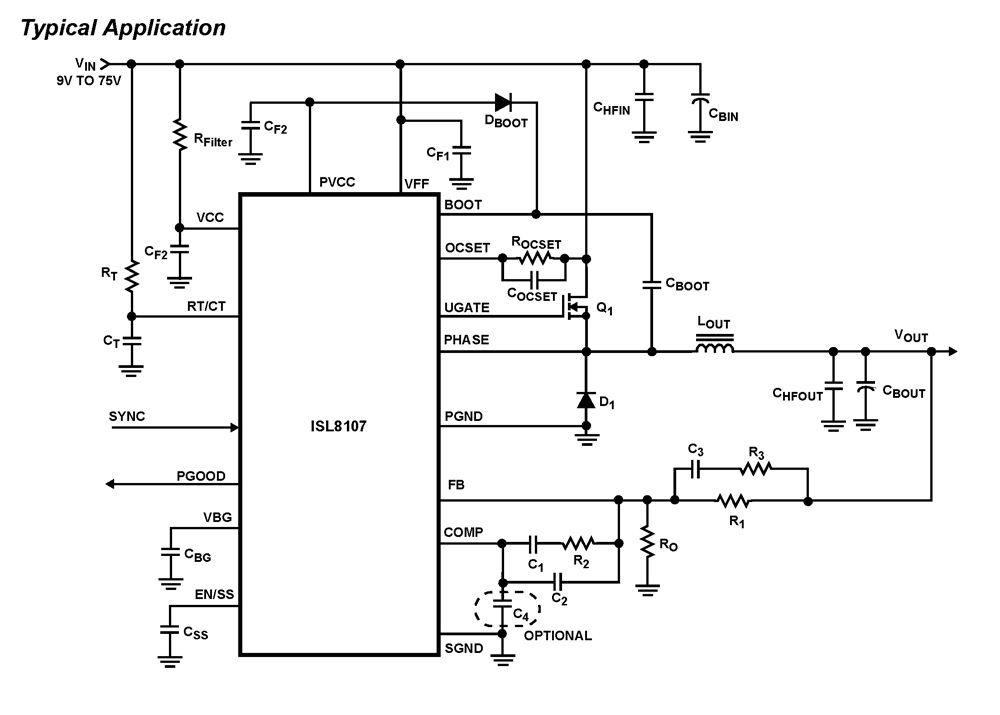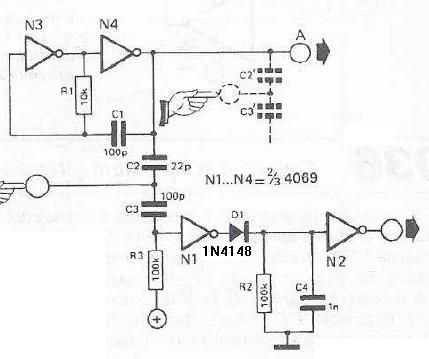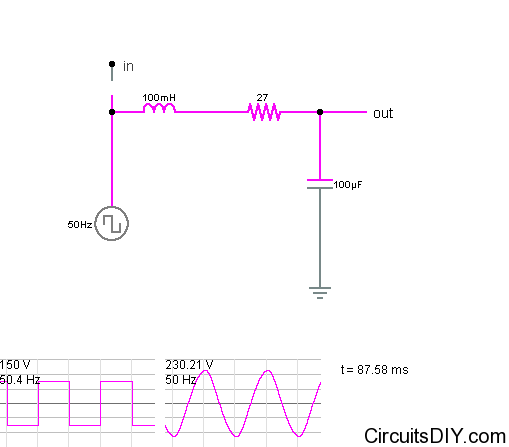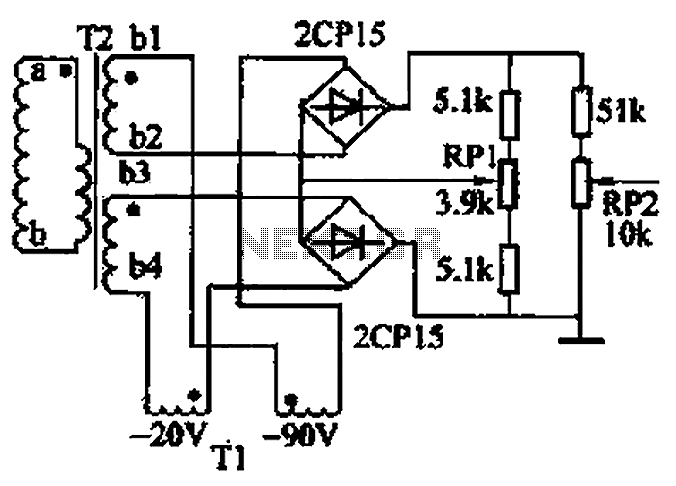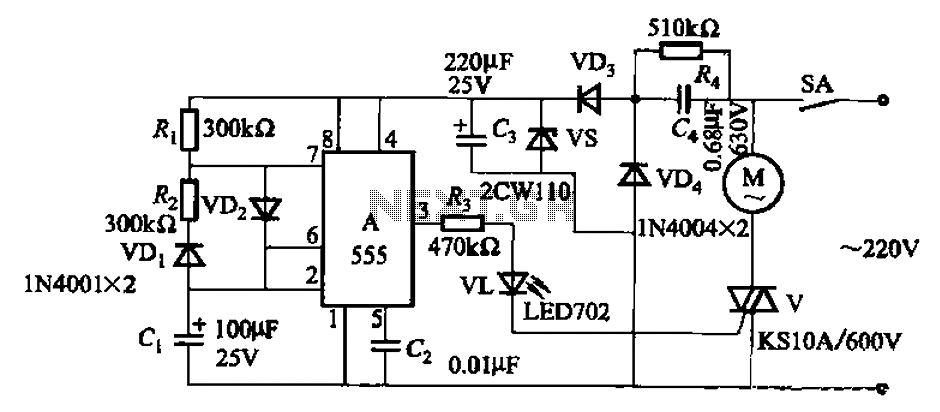
Single-Phase Inverters
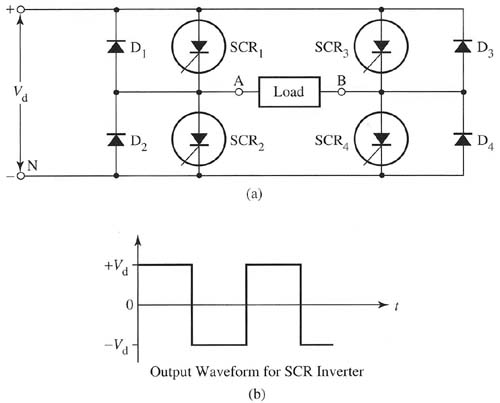
The simplest inverter to understand is the single-phase inverter, which converts a DC input voltage into single-phase AC voltage. The main components of the inverter can be either four silicon-controlled rectifiers (SCRs) or four transistors. A typical inverter circuit that uses four SCRs is depicted in a schematic, while another circuit that employs four transistors is also available. Originally referred to as a DC-link converter, it is now commonly called an inverter. The electrical schematic illustrates four SCRs utilized in the inverter circuit. In this configuration, SCR1 and SCR4 are triggered simultaneously to conduct the positive portion of the AC waveform, while SCR2 and SCR3 are triggered simultaneously to conduct the negative portion of the AC waveform. The output voltage waveform is characterized as an AC square wave. A phase-angle control circuit is implemented to determine the firing angle, which regulates the timing for activating each SCR to generate the AC square wave. The load is connected to the two terminals where the AC square wave voltage is delivered.
The single-phase inverter is a crucial component in various applications, including renewable energy systems and motor drives. The inverter's operation hinges on the precise control of the firing angles of the SCRs, which allows for modulation of the output voltage and frequency. The phase-angle control circuit typically employs a microcontroller or a dedicated integrated circuit to manage the timing of the SCR firing.
In the SCR-based inverter configuration, the four SCRs are arranged in a bridge topology, forming two pairs that correspond to the positive and negative halves of the AC waveform. When SCR1 and SCR4 are triggered, current flows through the load in one direction, producing the positive half-cycle. Conversely, triggering SCR2 and SCR3 allows current to flow in the opposite direction, generating the negative half-cycle. The result is an output waveform that approximates a square wave, which can be further processed using filters to produce a more sinusoidal output if required.
The load connected to the inverter may vary, ranging from resistive loads, such as incandescent lamps, to inductive loads, such as motors. The design of the inverter must take into account the load characteristics to ensure stable operation and to avoid issues such as voltage spikes or distortion in the output waveform.
In summary, the single-phase inverter using SCRs is a fundamental circuit for converting DC to AC, with applications in various electrical systems. Its operation relies on effective control of the SCR firing sequence, which is essential for generating the desired AC waveform and ensuring compatibility with the connected load.The simplest inverter to understand is the single-phase inverter, which takes a dc input voltage and converts it to single-phase ac voltage. The main components of the inverter can be either four silicon controlled rectifiers (SCRs) or four transistors.
Fig. 1 shows a typical inverter circuit that uses four SCRs, and Fig. 2 shows a typical inverte r circuit that uses four transistors. Originally called a dc-link converter, now it`s simply called an inverter. Above: Fig. 1 (a) Electrical schematic of a typical inverter circuit that uses four silicon controlled rectifiers (SCRs). (b) Output waveform for SCR inverter. The diagram in Fig. 1 shows four SCRs used in the inverter circuit. In this circuit SCR1, and SCR4 are fired into conduction at the same time to provide the positive part of the ac waveform and SCR2 and SCR3 are fired into conduction at the same time to provide the negative part of the ac waveform.
The waveform for the ac output voltage is shown in this figure - notice that it`s an ac square wave. A phase-angle control circuit is used to determine the firing angle, which provides the timing for turning each SCR on so that they provide the ac square wave. The load is attached to the two terminals where the ac square wave voltage is supplied. 🔗 External reference
The single-phase inverter is a crucial component in various applications, including renewable energy systems and motor drives. The inverter's operation hinges on the precise control of the firing angles of the SCRs, which allows for modulation of the output voltage and frequency. The phase-angle control circuit typically employs a microcontroller or a dedicated integrated circuit to manage the timing of the SCR firing.
In the SCR-based inverter configuration, the four SCRs are arranged in a bridge topology, forming two pairs that correspond to the positive and negative halves of the AC waveform. When SCR1 and SCR4 are triggered, current flows through the load in one direction, producing the positive half-cycle. Conversely, triggering SCR2 and SCR3 allows current to flow in the opposite direction, generating the negative half-cycle. The result is an output waveform that approximates a square wave, which can be further processed using filters to produce a more sinusoidal output if required.
The load connected to the inverter may vary, ranging from resistive loads, such as incandescent lamps, to inductive loads, such as motors. The design of the inverter must take into account the load characteristics to ensure stable operation and to avoid issues such as voltage spikes or distortion in the output waveform.
In summary, the single-phase inverter using SCRs is a fundamental circuit for converting DC to AC, with applications in various electrical systems. Its operation relies on effective control of the SCR firing sequence, which is essential for generating the desired AC waveform and ensuring compatibility with the connected load.The simplest inverter to understand is the single-phase inverter, which takes a dc input voltage and converts it to single-phase ac voltage. The main components of the inverter can be either four silicon controlled rectifiers (SCRs) or four transistors.
Fig. 1 shows a typical inverter circuit that uses four SCRs, and Fig. 2 shows a typical inverte r circuit that uses four transistors. Originally called a dc-link converter, now it`s simply called an inverter. Above: Fig. 1 (a) Electrical schematic of a typical inverter circuit that uses four silicon controlled rectifiers (SCRs). (b) Output waveform for SCR inverter. The diagram in Fig. 1 shows four SCRs used in the inverter circuit. In this circuit SCR1, and SCR4 are fired into conduction at the same time to provide the positive part of the ac waveform and SCR2 and SCR3 are fired into conduction at the same time to provide the negative part of the ac waveform.
The waveform for the ac output voltage is shown in this figure - notice that it`s an ac square wave. A phase-angle control circuit is used to determine the firing angle, which provides the timing for turning each SCR on so that they provide the ac square wave. The load is attached to the two terminals where the ac square wave voltage is supplied. 🔗 External reference
